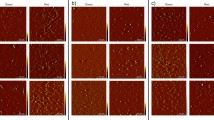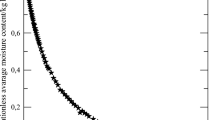Abstract
In this study, the effects of microwave radiation intensity, radiation time and initial wood moisture content (MC) on the properties of temperature development in Eucalyptus urophylla wood samples during the microwave explosion pretreatment have been investigated using a new microwave pretreatment equipment. The results show that 1) with the increase of microwave radiation intensity and a decrease in initial wood MC, both the average temperature and its rate of increase in wood rise rapidly; 2) with an increase in microwave radiation time, the average temperature of wood clearly increases, while the rate of increase in temperature shows a decline. In the microwave explosion pretreatment, the temperature development curve presented two patterns of variation: i) a sharp increase in temperature — a constant temperature — a slow warm-up and ii) a sharp increase in temperature — a rapid decline in temperature — a slow warm-up.
Similar content being viewed by others
References
Cai Y C, Hayashi K. 2007. New monitoring concept of moisture content distribution in wood during RF/vacuum drying. J Wood Sci, 53(1): 1–4
Harris G A, Torgovnikov G, Vinden P, Brodie G I, Shaginov A. 2008. Microwave pretreatment of backsawn messmate boards to improve drying quality: Part 1. Drying Technol, 26(5): 579–584
Liu H H, Wang Q W, Yang L, Jiang T, Cai Y C. 2005. Modification of larch wood by intensive microwave irradiation. J For Res, 16(3): 237–240
Liu Z J, Zhang B G, He H K. 2006. Variation property of stream pressure and temperature in wood during microwave drying. J Beijing For Univ, 28(6): 124–127 (in Chinese with English abstract)
Simon R P, Hann J A, Vinden P. 2007. Assessment of commercial low viscosity resins as binders in the wood composite material Vintorg. Holz Roh Werkst, 65: 209–214
Torgovnikov G, Vinden P. 2000. New wood based materials TORGVIN and VINTORG. 5th Pacific Rim bio-based Composite Symposium. Canberra, Australia
Torgovnikov G, Vinden P. 2001. Microwave method for increasing the permeability of wood and its applications. The 8th International Conference on Microwave and High Frequency Heating Symposium. Bayreuth, Germany
Torgovnikov G, Vinden P. 2004. New microwave technology and equipment for wood modification. Proceedings of the Fourth World Congress on Microwave and Radio Frequency Application. Austin Texas, USA
Torgovnikov G, Vinden P. 2005. New equipment for microwave wood modification. 10th International Conference on Microwave and RH Heating. Modena, Italy
Torgovnikov G, Vinden P. 2006. New 300 kW plant for microwave wood modification. International Microwave Power Institute’s 40th Annual Symposium. Boston, USA
Zhou Y D, Fu F, Li X J, Jiang X M, Chen Z L. 2009. Effects of microwave treatment on residue growth stress and microstructure of Eucalyptus urophylla. J Beijing For Univ, 31(2): 146–150 (in Chinese with English abstract)
Author information
Authors and Affiliations
Corresponding author
Rights and permissions
About this article
Cite this article
Li, Xj., Lu, Ky., Lin, Ly. et al. Fundamental characteristics of microwave explosion pretreatment of wood I. Properties of temperature development. For. Stud. China 12, 9–13 (2010). https://doi.org/10.1007/s11632-010-0004-7
Received:
Accepted:
Published:
Issue Date:
DOI: https://doi.org/10.1007/s11632-010-0004-7




